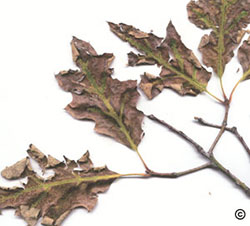 As the growing season progresses into late summer, leaves on many plants begin to exhibit tip burn or more significant scorch. When a plant has been scorched, the veins in its leaves remain green and the tissue between the veins turns brown and brittle. A plant can scorch when something interferes with the tree’s complex process of water uptake and water loss.
As the growing season progresses into late summer, leaves on many plants begin to exhibit tip burn or more significant scorch. When a plant has been scorched, the veins in its leaves remain green and the tissue between the veins turns brown and brittle. A plant can scorch when something interferes with the tree’s complex process of water uptake and water loss.
A plant’s root system serves many purposes; one of the most important is water uptake. As the root system absorbs water, the plant balances taking in new water by losing some water through openings in leaves and stems. This process is called transpiration.
Water uptake and loss can be affected by many factors including hot, dry, windy conditions, lack of soil moisture or lack of soil oxygen. A combination of these factors creates an imbalance between water uptake and water loss.
Soils in urban areas can be packed and not drain properly, causing low oxygen content. Roots, which may not function properly in these conditions, cannot replace water fast enough to keep up with what is lost through transpiration.
To manage a leaf scorch problem, check soil moisture by taking a sample about three to six inches deep just beyond the plant. If the soil is dry, add water. Deep infrequent watering is more beneficial for plant growth than frequent, light watering. If the soil is too wet, let the soil dry out slightly before watering again.
For more information, see the following Colorado State University Extension fact sheet(s).
- Environmental Disorders of Woody Plants
- Vegetable garden: Soil Management and Fertilization
- Choosing a Soil Amendment



